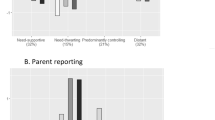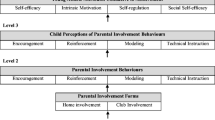Abstract
This study aimed to investigate how gender is related to parent–adolescent attachment and the perception of interpersonal relationships in sports teams. The second goal was to explore whether there are gender differences in the relations between adolescent attachment and their interpersonal relationships in sport-related contexts. The sample included 120 adolescents (59 girls), aged 12 to 15 years. The adolescents completed questionnaires regarding their attachment with their parents and the quality of the relationship with their best friend within the team. The adolescent social competence was rated by their team members and coaches. Compared to boys, girls reported higher levels of benefits of their relationship with their best friend and received higher ratings of social competence from their team mates and coaches. The strengths of the associations between attachment characteristics and interpersonal relationships, however, did not differ based on children’s gender. Our findings suggest the importance of gender in relation to attachment style and interpersonal relationships and reveal that the associations between these variables are similar across the gender group.
Similar content being viewed by others
References
Ainsworth, M. D. S., Blehar, M. C., Waters, E., & Wall, S. (1978). Patterns of attachment: Assessed in the strange situation and at home. Hillsdale, NJ: Erlbaum.
Bakermans-Kranenburg, M. J., & van IJzendoorn, M. H. (2009). No reliable gender differences in attachment across the lifespan. Commentary on Del Giudice: Sex, attachment, and the development of reproductive strategies. Behavioral and Brain Sciences, 32, 22–23.
Barbee, A. P., Cunningham, M. R., Winstead, B. A., Derlega, V. J., Gulley, M. R., Yankeelov, P. A., et al. (1993). Effects of gender role expectation on the social support process. Journal of Social Issues, 49(3), 175–190.
Berndt, T. J. (1996). Exploring the effects of friendship quality on social development. In W. M. Bukowski, A. F. Newcomb, & W. W. Hartup (Eds.), The company they keep: Friendship in childhood and adolescence (pp. 346–365). New York: Cambridge University Press.
Bohlin, G., Hagekull, B., & Rydell, A. (2000). Attachment and social functioning: A longitudinal study from infancy to middle childhood. Social Development, 9, 24–39.
Bosmans, G., & Kerns, K. A. (2015). Attachment in middle childhood: Progress and prospects. New Directions for Child and Adolescent Development, 148, 1–14.
Bowlby, J. (1969/1982). Attachment and loss. Attachment, Vol. 1. New York: Basic.
Brennan, K. A., Clark, C. L., & Shaver, P. R. (1998). Self-report measurement of adult romantic attachment: An integrative overview. In J. A. Simpson & W. S. Rholes (Eds.), Attachment theory and close relationships (pp. 46–76). New York: Guilford Press.
Brumariu, L., & Kerns, K. A. (2010). Parent–child attachment and internalizing symptoms in childhood and adolescence: A review of empirical findings and future directions. Development and Psychopathology, 22, 177–203.
Bruner, M. W., Carreau, J., Wilson, K. S., & Penney, M. (2014). Group norms in youth sport: Role of personal and social factors. The Sport Psychologist, 28, 323–333.
Carr, S. (2009). Adolescente-parent attachment characteristics and quality of youth sport friendship. Psychology of Sport and Exercise, 10, 653–661.
Carr, S., & Fitzpatrick, N. (2011). Experiences of dyadic sport friendships as a function of self and partner attachment characteristics. Psychology of Sport and Exercise, 12(4), 383–391.
Chen, B. (2012). The association between self-reported mother–child attachment and social initiative and withdrawal in Chinese school-aged children. The Journal of Genetic Psychology: Research and Theory on Human Development, 173(3), 279–301.
Choi, S., Hutchison, B., Lemberger, M. E., & Pope, M. (2012). A longitudinal study of the developmental trajectories of parental attachment and career maturity of South Korean adolescents. Career Development Quarterly, 60, 163–177.
Coakley, J., & White, A. (1992). Making decisions: gender and sport participation among British adolescents. Sociology of Sport Journal, 9, 20–35.
Davis, L., & Jowett, S. (2010). Investigating the interpersonal dynamics between coaches and athletes based on fundamental principles of attachment. Journal of Clinical Sport Psychology, 4, 112–132.
Davis, L., Jowett, S., & Lafreniere, M.-A. K. (2013). An attachment theory perspective in the examination of relational processes associated with coach-athlete dyads. Journal of Sport & Exercise Psychology, 35, 156–167.
DeKlyen, M., & Greenberg, M. T. (2008). Attachment and psychopathology in childhood. In J. Cassidy & P. R. Shaver (Eds.), Handbook of attachment: Theory, research, and clinical applications (2nd ed., pp. 637–665). New York, NY: Guilford Press.
Del Giudice, M. (2008). Sex-biased ratio of avoidant/ambivalent attachment in middle childhood. British Journal of Developmental Psychology, 26, 369–379.
Del Giudice, M. (2009). Sex, attachment, and the development of reproductive strategies. Behavioral and Brain Sciences, 32, 1–67.
Fearon, P. R., Bakermans-Kranenburg, M. J., van IJzendoorn, M. H., Lapsley, A.-M., & Roisman, G. I. (2010). The significance of insecure attachment and disorganization in the development of children’s externalizing behavior: A meta-analytic study. Child Development, 81(2), 435–456.
Felton, L., & Jowett, S. (2013). Attachment and well-being: The mediating effects of psychological needs satisfaction within the coach-athlete and parent-athlete relational contexts. Psychology of Sport and Exercise, 14, 57–65.
Groh, A. M., Fearon, P. R., Bakermans-Kranenburg, M. J., Van IJzendoorn, M. H., Steele, R. D., & Roisman, G. I. (2014). The significance of attachment security for children’s social competence with peers: A meta-analytic study. Attachment & Human Development, 16(2), 103–136.
Jowett, S., & Cramer, D. (2010). The prediction of young athletes’ physical self from perceptions of relationships with parents and coaches. Psychology of Sport and Exercise, 11(2), 140–147.
Kerns, K. A., & Brumariu, L. E. (2016). Attachment in middle childhood. In J. Cassidy & Philip Shaver (Eds.), Handbook of attachment, 3rd ed (pp. 349–365), NY: Guilford.
Kerns, K. A., Klepac, L., & Cole, A. (1996). Peer relationships and preadolescents’ perceptions of security in the child–mother relationship. Developmental Psychology, 32, 457–466.
Kobak, R. R., Cole, H. E., Ferenz-Gillies, R., Fleming, W. S., & Gamble, W. (1993). Attachment and emotion regulation during mother-teen problem solving: A control theory analysis. Child Development, 64, 231–245.
Kunesh, M. A., Hasbrook, C. A., & Lewthwaite, R. (1992). Physical activity socialization: Peer interactions and affective responses among a sample of sixth grade girls. Sociology of Sports Journal, 9, 385–396.
Leaper, C. (2002). Parenting girls and boys. In M. H. Bornstein (Ed.), Handbook of parenting: Children and parenting (Vol. 1, pp. 189–225). Mahwah, NJ: Erlbaum.
Lyons-Ruth, K., & Jacobvitz, D. (2008). Attachment disorganization: Genetic factors, parenting context, and developmental transformation from infancy to adulthood. In J. Cassidy & P. R. Shaver (Eds.), Handbook of attachment: Theory, research, and clinical applications (2nd ed., pp. 667–697). New York: Guilford Press.
Main, M., & Solomon, J. (1986). Discovery of a new, insecure–disorganized/disoriented attachment pattern. In T. B. Brazelton & M. V. Yogman (Eds.), Affective development in infancy (pp. 95–124). Norwood: Ablex.
Martin, J. J., & Smith, K. (2002). Friendship quality in youth disability sport: Perceptions of a best friend. Adapted Physical Activity Quarterly, 19(4), 472–482.
Pallini, S., Baiocco, R., Schneider, B. H., Madigan, S., & Atkinson, L. (2014). Early child–parent attachment and peer relations: A meta-analysis of recent research. Journal of Family Psychology, 28(1), 118–123.
Parker, J. G., & Asher, S. R. (1993). Friendship and friendship quality in middle childhood: Links with peer group acceptance and feelings of loneliness and social dissatisfaction. Developmental Psychology, 29, 611–621.
Rose, A. J., & Rudolph, K. D. (2006). A review of sex differences in peer relationship processes: Potential trade-offs for the emotional and behavioral development of girls and boys. Psychological Bulletin, 132, 98–131.
Rubin, K. H. (2004). Three things to know about friendship. Newsletter International Society for the Study of Behavioral Development, 46(2), 5–7.
Rubin, K. H., & Asendorpf, J. (1993). Social withdrawal, inhibition, and shyness in childhood: Conceptual and definitional issues. In K. H. Rubin & J. B. Asendorpf (Eds.), Social withdrawal, inhibition and shyness in children (pp. 3–17). Hillsdale, NJ: Erlbaum.
Ruhl, H., Dolan, E. A., & Buhrmester, D. (2015). Adolescent attachment trajectories with mothers and fathers: the importance of parent–child relationship experiences and gender. Journal of Research on Adolescence, 25(3), 427–442.
Rys, G. S., & Bear, G. G. (1997). Relational aggression and peer relations: Gender and developmental issues. Merrill-Palmer Quarterly, 43(1), 87–106.
Schneider, B. H., Atkinson, L., & Tardif, C. (2001). Child-parent attachment and children’s peer relations a quantitative review. Developmental Psychology, 37(1), 86–100.
Sevdalis, V., & Raab, M. (2014). Empathy in sports, exercise, and the performing arts. Psychology of Sport and Exercise, 15, 173–179.
Shomaker, L. B., & Furman, W. (2009). Parent–adolescent relationship qualities, internal working models, and styles as predictors of adolescents’ observed interactions with friends. Journal of Social and Personal Relationships, 26, 579–603.
Tucker, L. W., & Parks, J. B. (2001). Effects of gender and sport type on intercollegiate athletes’ perceptions of the legitimacy of aggressive behaviors in sport. Sociology of Sport Journal, 18, 403–413.
Ullrich-French, S., & Smith, A. L. (2006). Perceptions of relationships with parents and peers in youth sport: independent and combined prediction of motivational outcomes. Psychology of Sport and Exercise, 7, 193–214.
Ullrich-French, S., & Smith, A. L. (2009). Social and motivational predictors of continued youth soccer participation. Psychology of Sport and Exercise, 10, 87–95.
Van IJzendoorn, M. H., & Sagi, A. (1999). Cross-cultural patterns of attachment: Universal and contextual dimensions. In J. Cassidy & P. R. Shaver (Eds.), Handbook of attachment: Theory, research and clinical applications (pp. 713–734). New York: Guilford Press.
Weiss, M. R., & Smith, A. L. (1999). Quality of youth sport friendships: Measurement development and validation. Journal of Sport & Exercise Psychology, 21, 145–166.
Weiss, M. R., & Smith, A. L. (2002). Friendship quality in youth sport: relationship to age, gender, and motivation variables. Journal of Sport & Exercise Psychology, 24, 420–437.
Weiss, M. R., Smith, A. L., & Theeboom, M. (1996). ”That’s what friends are for”: children’s and teenagers’ perceptions of peer relationships in the sport domain. Journal of Sport & Exercise Psychology, 18, 347–379.
West, W., Rose, S. M., Spreng, S., Sheldon-Keller, A., & Adam, K. (1998). Adolescent attachment questionnaire: A brief assessment of attachment in adolescence. Journal of Youth and Adolescence, 27, 661–673.
Zhang, F., You, Z., Fan, C., Gao, C., Cohen, R., Hsueh, Y., et al. (2014). Friendship quality, social preference, proximity prestige, and self-perceived social competence: Interactive influences on children’s loneliness. Journal of School Psychology, 52, 511–526.
Author information
Authors and Affiliations
Corresponding author
Ethics declarations
Conflict of interest
Both authors have no conflict of interest.
Ethical Approval
All procedures performed in studies involving human participants were in accordance with the ethical standards of the institutional research committee and with the 1964 Helsinki declaration and its later amendments or comparable ethical standards.
Informed Consent
Informed consent was obtained from all individual participants included in the study.
Rights and permissions
About this article
Cite this article
Diaconu-Gherasim, L.R., Duca, D.S. Parent–Adolescent Attachment and Interpersonal Relationships in Sports Teams: Exploring the Gender Differences. Gend. Issues 35, 21–37 (2018). https://doi.org/10.1007/s12147-017-9190-0
Published:
Issue Date:
DOI: https://doi.org/10.1007/s12147-017-9190-0




